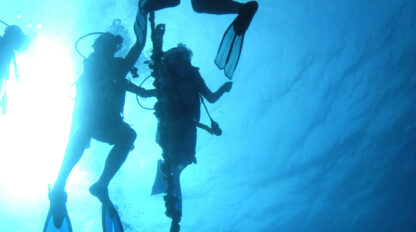Small versus Large Sailboats


Most sailors first find their love for the sport not on 50′ Beneteau sloops, but on sailing dinghies or small sailboats like Hobie-cats, 420s, and of course the popular Laser. These boats are fun for both amateurs and seasoned racers.
One might feel a little intimidated when moving from these “easy to sail” boats to the seemingly mammoth 30′ and larger yachts, complete with heavy fixed keels, winches, wheels at the helm, lifelines and maybe even swimming platforms. Don’t be! From Lasers to America’s Cup racers, boats powered by the interaction of wind and sail share the same physical principles, so if you’ve sailed one, you’ve sailed them all …almost.
Let’s look at similarities and differences between small and large sailboats by comparing the 14′ Laser, the 19′ Flying Scot, and the 50′ Beneteau.

What do they have in common?
Briefly, they all have a hull to keep the water out, a rudder to steer the boat moving through the water, sails to “catch the wind” and propel the boat forward, spars (mast & boom) to hold the sails up, and running rigging to control the sails’ shape and angle to the wind. The concepts behind each of these are the same across every sailboat.
The differences?
Minor differences include the type of helm and the number of sails, both of which become inconsequential when one has a solid foundation in small boat sailing. Small sailboats typically have tillers to control the rudder in the water, while larger keelboats often have wheels to do the same job. The principles of steering are the same between the two, so most sailors can make the transition easily. Similarly, the number of sails varies on these boats, but the concept of sail trim is the same, so most people also manage this transition.

The more significant differences are in the keel/centerboard/daggerboard extending below the hull and in the forces involved when sailing boats varying so much in size and weight (or displacement).
All three sailboats have blade-like structures extending below their hulls that enable the boats to move forward and prevent the boats from moving sideways. A Laser has a lightweight daggerboard, pushed down by hand through the hull from above. The Flying Scot has a medium-weight centerboard that pivots up and down from a slot within the hull. And the 50′ Beneteau has a heavy fixed keel attached to its hull. Except when sailing directly downwind, the wind in the sails creates a lateral force on the boat and the daggerboard, centerboard or keel converts that lateral pressure into forward motion.

The difference is in the weight. On a Laser, the daggerboard only provides lateral resistance and the sailor must use his/her own body weight to keep the boat upright as the sails catch the wind. On a large sailboat, in addition to the lateral resistance, the keel also provides ballast at the lowest point below the waterline to counteract that tipping effect of the wind in the sails. A centerboard falls inbetween the two in this regard, providing lateral resistance as well as some ballast effect, though a centerboard cannot be too heavy since it still needs to be raised and lowered.
Small boat sailors, who learned to capsize and right their boat as part of their basic training, sometimes incorrectly assume large boats can similarly capsize. However, the keel on a large sailboat is sufficiently heavy that capsizing is extremely rare. Even if a really, really strong gust of wind pushes the boat way over, the weight of the keel will “automatically” right the boat when the gust passes – no need to swim around and stand on the daggerboard. And note there is also a self-correcting aspect when a large boat heels over because the sail area exposed to the wind’s force gets smaller and smaller the further the boat leans.

(Note this heeling effect on the sail area does not happen with catamarans, but that’s another story for another time.)
The other important adjustment when moving from small to large boats relates to the size and weight (or displacement) differences between these boats. On a Laser, the entire hull is within 8 feet of the person steering the boat. This 130 lb sailboat is highly responsive to tiller movement, and is easily maneuvered through wind shifts. On the other hand, the bow of a 50′ Beneteau is about 45′ away from the helm (hard to see for the person at the wheel) and the responsiveness to the helm is correspondingly slower. On a yacht, sails are larger, heavier and catch more wind, so the sheets controlling those sails are larger and under more strain. A 50′ Beneteau yacht weighs 15 tons and when underway, either by sail or motor, represents a lot of momentum. For all these reasons, maneuvers need to be planned in advance and coordinated with the crew. Safety considerations are very important and communication among all onboard is critical.
Even so, our overall message remains – the concepts at play on all sailboats are the same – small boat sailing skills are readily transferable to big boats, and vice versa. If you have already mastered sailing on one kind of boat, challenge yourself on a different size and style vessel. The more you sail and the more types of sailing you try out, the better you’ll get!

